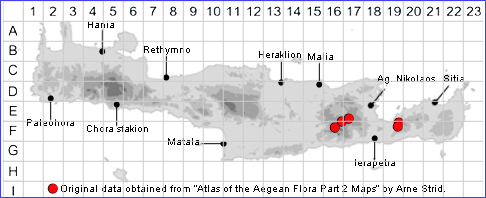
INULA PSEUDOLIMONELLA
Family and Genus:- See- COMPOSITAE/I. CANDIDA Group
Common Names:- None
Homotypic Synonyms:- Inula candida subsp.decalvans, Inula limonifolia.
Meaning:- Inula (L) A name used by the Roman naturalist and natural philosopher
Pliny.
Pseudolimonella. Meaning unclear.
General description:- Perennial, whitish-silvery shrub.
Stems:-
1) 10 cm, slender, simple or with few short branches in the upper 1/3. Indumentum
dense or moderately dense, appressed-sericeous-tomentose.
Leaves:-
1) Simple, alternate.
2) Basal,1·5-3·5 cm usually lanceolate and gradually narrowed into the petiole,
obtuse, entire; veins not prominent beneath.
Flowers:-
1) Capitula, medium-sized with yellowish florets, very tiny, difficult to be observed,
usually supported or enfold by several bracts.
2) Involucre bracts, 8-9 mm, recurved, usually with an elongate apex.
a) outer involucral bracts, more than ½ as long as inner.
Fruit:-
1) Achenes, c. 2 mm, hairy; angled, not abruptly contracted below the pappus.
2) Pappus, about twice as long as the achene, with 10-15 setae.
Key features:-
1) Involucre, 8-9(-11) mm.
2) Involucral bracts, recurved near the usually elongate apex.
a) outer, more than ½ as long as the inner.
3) Most capitula, subtended by 2 or more bracts.
4) Stem and leaves, more or less densely appressed-sericeous-tomentose.
5) Leaves, entire.
6) Indumentum, very dense.
7) Basal leaves, 1·5-3·5 cm
8) Stems, usually not more than 10 cm.
Habitat:- Calcareous cliffs. 0-1000(-1400)m.
Distribution:- Endemic to the Dikti and Afendis Kavousi massifs, E. Crete. Rare.
Flowering time:- May-July.
Photos by:- Steve Lenton
Status:-
Conservation status (for threatened species):-Rare (R) according to IUCN 1997.
Protection status (for threatened species):- Greek Presidential Decree 67/1981.
SPECIES DESCRIPTION
